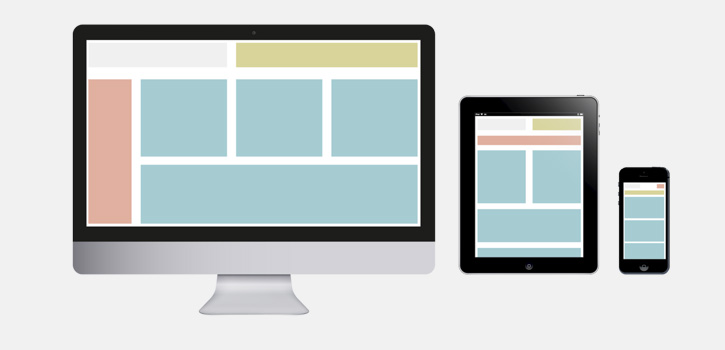There is a lot of hullabaloo about Responsive Web Design (RWD). Why not? After all Google recommends Responsive Web Design. So is it time for you to join the RWD bandwagon?
With mobile internet surpassing the desktop-only era, with loads of tablets and mini tablets coming up and new phenomenon called ‘phablets’ hitting the scene; should adapting designs and websites for multiple devices and screen sizes considered to be the only factor for better user experience? Are we undermining the importance of optimizing site performance for a better mobile experience? Is user experience all about adapting the layout?
Do you need responsive web design or want it when you don’t need it?

Is this sudden “want for responsive web design” triggered because of all the hype created by experts? Before you take a leap towards the responsive world, it is imperative that you understand your website traffic such as what devices are being used to view your site and make an informed decision. There is no doubt that we are living in the era where mobile strategy is important to survive. But if you merely implement RWD without understanding the psyche of your user or your business goals, you are in for a roller coaster ride.
Just think about it, you are a real estate agency, most likely your customers are looking for information about properties and want to know every little detail about the property. Be it images of all the possible rooms, backyard, so on and so forth, location, or stats, customers wants to know everything. In such case, will providing less data to a mobile user compared to desktop users work against you?
It is important to understand the mobile users need information they are looking for at lightening fast speed. With a responsive design, your scripts, code, and every other thing—loads for mobile users. This could be excruciatingly painful for mobile users. If mobile browsing is crucial for your business, you need to think of novel ways to optimize your site for speed and give user EXACTLY what he is looking for. Don’t try to sell apples to your customer when he is looking for oranges.

Responsive design is not a be all and end all solution in web designing. Here are the reasons holding back responsive web design from becoming the future.
Responsive Web Design: On the flip side
Slow implementation rates: Responsive designs is a complex solution and could take almost twice as long to design and implement compared to fixed-width designs. For those who thought fixed width sites are difficult to manage just imagine designing and tweaking sites for different resolution points. Let us not forget the rigorous testing needed as we are talking about tons of web-enabled devices. Don’t you think this valuable time could have been better spent improving other areas of your products or services.
One-size-fits-all approach does not always work
RWD delivers the exact content and experience to all device users. Are we forcing users to go through the same experience on every device? Let us not underestimate the fact that many times a device changes the needs and behavior of of users. For instance, smartphone owners on a shopping spree are focused on best deals and discounts The content they are looking for needs to be promotions based, and RWD can’t adapt to changing customer behavior. Because RWD simply does not provide customized experience. However, there are many industries where customization results in higher conversion. In such cases, RWD is not the right solution. So, it is important that based on user needs, the designer may need to offer up different content or functionality with respect to platform.
Design constraints
In this mad obsession of providing optimal viewing experience to user, designers are often confined within a certain limit and are expected to come up with design solutions suitable for different formats. This could invariably lead to compromised designs.
The Advertising angel
Sites that rely heavily on advertising as source of revenue need to exercise caution as responsive design can lead to heavily distorted ads. The advertising angel adds to the woes of designers as they have to consider diverse types of ads ranging from relatively simple text form, to banners, to the most complex animated ads.
Wrong audience
Responsive web design is certainly not the solution if only miniscule users of your site are from mobile devices. Think about your target audience first. You could be alienating the majority of your audience with responsive web design. Many users are likely to get confused with changed format of your site which will very likely affect credibility of your website.
Responsive Web Design: The road ahead
For those who consider Responsive web design an ultimate and perfect solution, it is time for some reality check. There is no doubt that Responsive web design is the one of the best solutions to provide an optimized website for all devices, from iPhone, to tablets, and android to large LED screens. If designed well Responsive websites can give good user experience on multiple devices. However, don’t just jump on responsive bandwagon because it is dubbed to be the coolest term in the IT industry. Think about your users needs and business priorities.
If you feel that RWD works against the best interests of your visitors, stay away from it. Several alterations of RWD are emerging and need careful review. These modified techniques aim to reduce the drawbacks of RWD and keep its benefits intact. This brand-new approach is called adaptive web design. Perhaps that is what future holds for RWD.
Conclusion
Responsive website design is the most feasible option for small websites or businesses that offer almost identical features to mobile and desktop audience. It might require an extensive investment of time and effort at the start, but is easier on maintenance as you can make updates for all devices against updating target specific websites.
